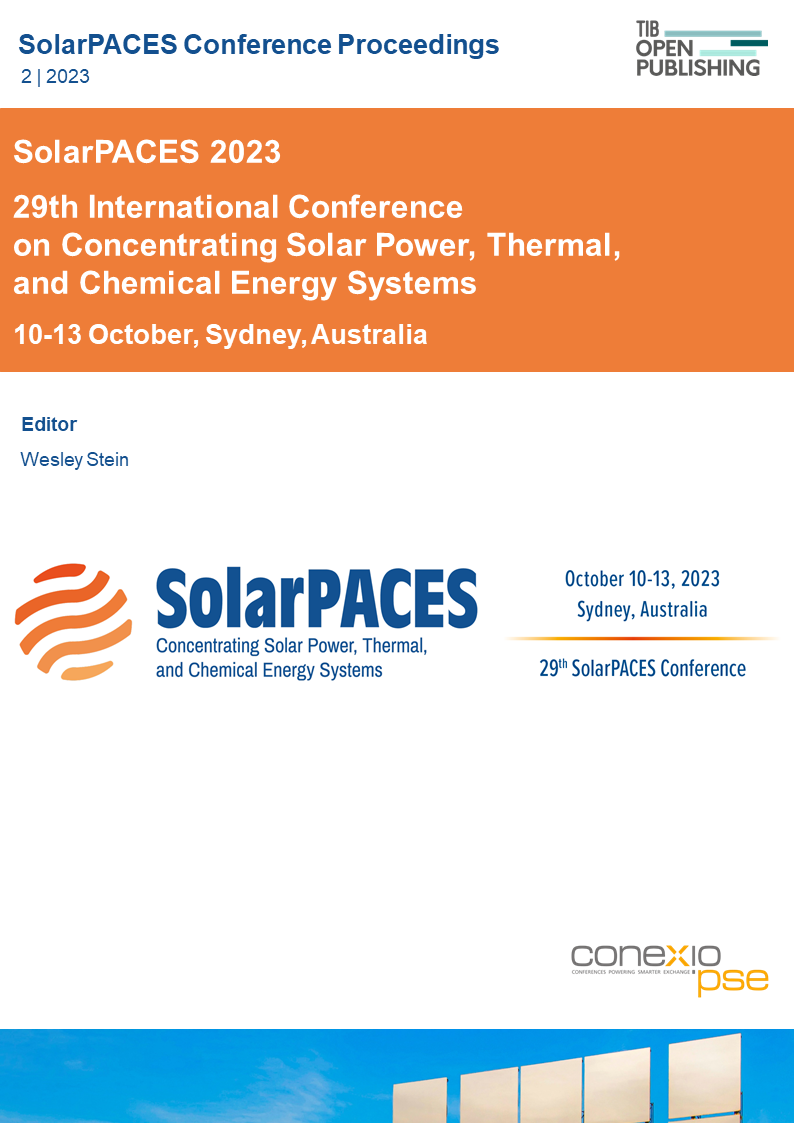Heat Transfer and Pressure Drop in Packed Beds of Crushed Rock Particles
DOI:
https://doi.org/10.52825/solarpaces.v2i.755Keywords:
Packed Bed, Crushed Rocks, Thermal Energy StorageAbstract
Thermal energy storage using packed beds of crushed rocks finds application in solar thermal power generation, building thermal comfort, and greenhouse climate control. Crushed rock particles are irregular in shape and size, but notwithstanding have a clearly discerning long, intermediate, and short axis. Consequently, particles tend to pack down with their short axis facing upwards. As a result, the flow resistance and heat transfer characteristics in a packed bed depend on the flow direction relative to particle orientation. For small applications, the flow through a packed bed is typically one-dimensional, and one may rely on empirical correlations for design purposes. In this work, we propose that tortuosity is included in the heat transfer and pressure drop correlations. We derived our correlations from a combination of discrete element modeling (DEM) and computational fluid dynamics (CFD) and verified our results experimentally.
Downloads
References
D.G. Kröger, (2011), The Stellenbosch University solar power thermodynamic cycle, https://sterg.sun.ac.za/wp-content/uploads/2011/05/SUNSPOT-2.pdf.
L.J. Heller and J.E. Hoffmann, (2015), A cost and performance evaluation of SUNDISC: a dual-pressure air receiver cycle, Proceedings of SolarPACES 2014, Beijing, China, Energy Procedia, Vol. 69, 1287 – 1295.
A.L. Avila-Marin, (2011), Volumetric receivers in solar thermal power plants with central receiver system technology: a review, Solar Energy, Vol. 85, pp. 891 – 911.
L.J. Heller and P. Gauché, (2014), Dual-pressure air receiver cycle for direct storage charging, Proceedings of SolarPACES 2013, Las Vegas, USA, Energy Procedia, Vol. 49, pp. 1400 – 1409.
K.G. Allen, (2014), Rock bed thermal storage for concentrating solar power plants, Ph.D. Thesis, Stellenbosch University.
H. Wadell, (1933), Sphericity and roundness of rock particles, The Journal of Geology, Vol. 41, No. 3, pp. 310 – 331.
P.J. Barret, (1980), The shape of rock particles: a critical review, Sedimentology, Vol. 27, pp. 291 – 303.
J.E. Hoffmann, (2022), Determining the particle heat transfer coefficient for an anisotropic bed of crushed rock particles, Proceedings of HEFAT 2022, Amsterdam, The Netherlands.
A. Dziugys, A.H. Mahmoudi, E. Misiulis, R. Navakas and G. Skarbalius, (2022), Fractal dependence of the packed bed porosity on the particles size distribution, Chaos, Solutions and Fractals, Vol. 159.
M. Rolland, A.D. Rakotonirina, A. Devassoux, G.L.B. Goycetti, J.Y. Delenne and A. Wachs, (2019), Predicting average void fraction and void fraction uncertainty in fixed beds of poly lobed particles, Industrial & Engineering Chemistry Research, Vol. 58, pp. 3902 – 3911.
C.G. du Toit and P.G. Rousseau, (2014), Separate effects tests to determine the pressure drop over packed beds in the PBMR HPTU test facility, Proceedings of HTR 2014, Weihai, China.
S. Ergun, (1949), Fluid flow through packed columns, Chemical Engineering Progress, Vol. 48, pp. 89 – 94.
B. Eisfeld and K. Schnitzlein, (2001), The influence of confining walls on the pressure drop in packed beds, Chemical Engineering Science, Vol. 56, pp. 4321 – 4329.
H. Martin, (2005), The Lévêque-analogy or how to predict heat and mass transfer from fluid friction, Proceedings of HEFAT 2014, Cairo, Egypt.
X. Li, M. Jiang, Z. Huang, and Q. Zhou, (2019), Effect of particle orientation on the drag force in random arrays of prolate ellipsoids in low Reynolds number flows, AIChE Journal, Vol. 65, pp. 1 – 11.
E.B.E. Hassan and J.E. Hoffmann, (2023), A DEM-CFD Approach for Predicting Pressure Drop through Packed Bed of Crushed Rocks, Proceedings of SolarPACES 2022, Albuquerque, USA.
ESSS Rocky, Release 2022 R2, User Manual, ESSS Rocky DEM, S.R.L., 2022.
ANSYS Academic Research Fluent, Release 2023 R1, Help System, Solution Mode, ANSYS, Inc.
Lemmon, E.W., Bell, I.H., Huber, M.L., McLinden, M.O., NIST Standard Reference Database 23: Reference Fluid Thermodynamic and Transport Properties-REFPROP, Version 9.1, National Institute of Standards and Technology, Standard Reference Data Program, Gaithersburg, 2018.
Wakao, N., Kaguei, S., and Funazkri, T., (1979), Effect of fluid dispersion coefficients on particle-to-fluid heat transfer coefficients in packed beds, Chemical Engineering Science, Vol. 34, pp. 325 – 336.
Safety Standards of the Nuclear Safety Standards Commission (KTA): KTA Rule 3102.3: Reactor Core Design of High-Temperature Gas-Cooled Reactors; Part 3: Loss of Pressure through Friction in Pebble Bed Cores, (March 1981).
Gnielinski V., Fluid-particle heat transfer in flow through packed beds of solids, chapter G9 in VDI Wärmeatlas, 2nd edition, Springer, Düsseldorf, (2010).
Fu, J., Thomas, H.R. and Li, C., (2021), Tortuosity of Porous Media: Image Analysis and Physical Simulation, Earth-Science Reviews, Vol. 212,
https://doi.org/10.1016/j.earscirev.2020.103439
Martin, H., (2005), The Lévêque Analogy, or How to Predict Heat and Mass Transfer from Fluid Friction, Proceedings of HEFAT 2005, Cairo, Egypt.
Downloads
Published
How to Cite
Conference Proceedings Volume
Section
License
Copyright (c) 2025 Jaap Hoffmann, Eduard Fourie

This work is licensed under a Creative Commons Attribution 4.0 International License.
Accepted 2025-03-04
Published 2025-07-18
